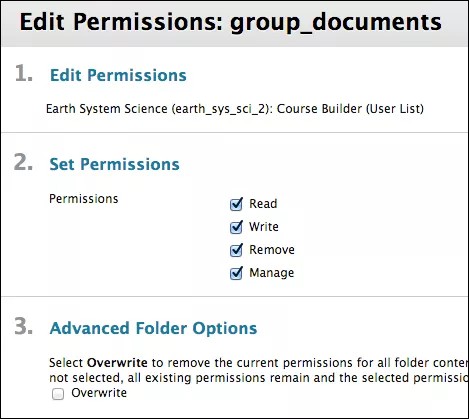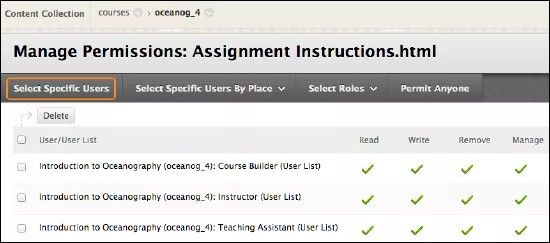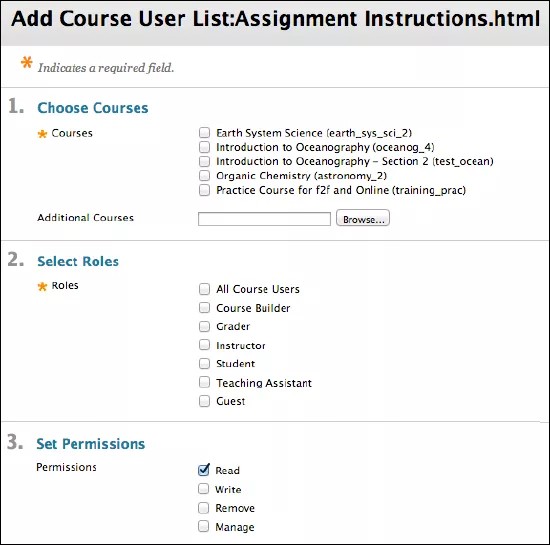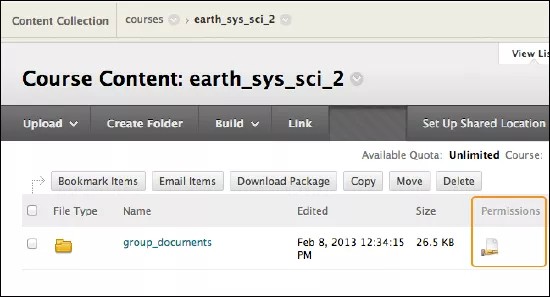As you organize folders and files, remember that permissions are inherited based on location
When you add folders and files to the Content Collection, keep in mind which users and user lists the content will be shared with.
You may find it helpful to organize folders in a way that lets you manage permissions by folder, rather than by file. You may find it difficult to manage items shared with the same users, but spread out among different folders. For example, create a folder that contains all files used in a group project. This way the entire folder may be shared with the group members, and you won't have to manage permissions on separate items stored in different folders.
More on organizing content in folders
Files are automatically available to the user who added the file but must be shared if you want other users to view it.
Files inherit permissions from the folder they reside in. If a file is added to a folder that already has read and write permission for certain users or user lists, then those same users will also have read and write permission on the newly added file.
More on how to share and find content in the Content Collection
Folder permissions are inherited by default. When you update user permissions for a folder, those permissions also automatically apply to all items (folder and files) contained within that folder. You may want to verify that users don't have unauthorized access to certain folders if you make changes to top-level folder permissions.
Permissions
Permission describes a user's or a group's ability to interact with a file or folder in the Content Collection.
- Read means that a user can only see, open, and download the item.
- Write means that a user has read permissions, and can also edit or overwrite the item, including the file name and settings. If the user has write permission for a folder, the user can also create new items (folders and files) within it.
- Remove means that a user has read and write permissions, and can also delete the item.
- Manage means that a user has full control of the item and can grant permissions to other users.
Assign permissions to individual users
In the Content Collection, navigate to the folder or file you want to assign permissions to.
- In the file or folder's row, select the icon in the Permissions column.
- On the Manage Permissions page, choose Select Specific Users.
- On the Add User page, type one or more usernames, separated by commas, or select Browse.
- To browse, type the search criteria in the Search For box and select Search.
- Select the check boxes next to the appropriate users and select Submit.
- On the Add User page, select the check boxes for the appropriate permissions.
- Select Submit.
Assign permissions to groups
To save time, you can assign permissions to groups of users:
- All members of a course you teach
- All users with specific roles in a course you teach, such as all teaching assistants
- All users assigned to select groups in a course you teach
Though you can add permissions for students, you might inadvertently allow students to access files that you don't want them to see yet. For example, in your course, you might "hide" a file from student view or apply an adaptive release/conditional availability rule. If you give permission for students to access the folder with the file from the Content Collection, they might be able to see the file sooner than you intended. For more information, visit the Common Questions topic.
When you set permissions for a group, the options vary based on the group selected.
- In the Content Collection, navigate to the folder or file you want to assign permissions to.
- In the file or folder's row, select the icon in the Permissions column.
- On the Manage Permissions page, choose Select Specific Users by Place.
- From the list, select a group.
- On the Add Course User List page, in the Choose Courses section, select the check boxes next to the appropriate courses.
- In the Select Roles section—only available for some user groups—select the check box next to the appropriate users. Or, narrow your selection by role.
- In the Set Permissions section, select the check boxes for the appropriate permissions.
- Select Submit.
Edit permissions
In the Content Collection, navigate to the folder or file.
- Select the Permissions icon for the file or folder.
- On the Manage Permissions page, next to the role in the User/User List column, open the item's menu.
- Select Edit.
Delete removes the role and the permissions for the file or folder. Select a function to restore a deleted role.
- On the Edit Permissions page, select or clear the check box next to the Permissions type. For folders, select the Overwrite check box to make these permissions changes for all folder contents and sub-folders and replace all existing permissions. When you do not select Overwrite, the selected permissions are added to all folder contents and sub-folders, but previously existing permissions are not removed.
- Select Submit.
- Select OK to return to Content Collection.
Option to overwrite folder permissions
When you edit or add permissions to a parent folder, you have the Overwrite option, which forces all files and sub-folders to inherit these permissions. For example, if the read and write permissions are added to the folder and you select Overwrite, all permissions to items within that folder would be reset to read and write. Any item within the folder that has other permissions, such as remove, would be reverted back to only read and write permissions.
If you don't select the Overwrite option, the files and sub-folders are automatically granted any additional permission given to the parent folder, but existing permissions are not deleted. For example, if read, write, and manage permissions are added to the folder, and an item within the folder already has read, write, and remove permissions, the permissions for the file would remain read, write, and remove, and manage would be added.
After you edit permissions on a folder, you may edit the permissions on an item, but these permissions are overwritten the next time permissions on the parent folder are edited. We recommend you store items with the same purpose and audience in a single folder. Then, you can manage permissions easily.



